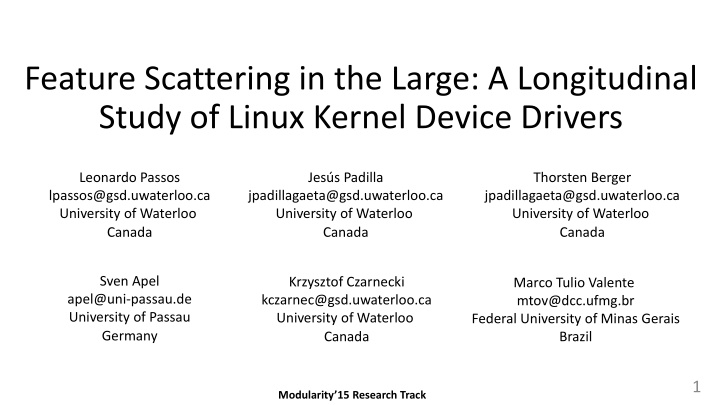
A Longitudinal Study of Feature Scattering in Linux Kernel Device Drivers
This study examines feature scattering in Linux kernel device drivers, highlighting how it impacts modularity, hindering parallel development, and leading to code tangling. Despite its challenges, feature scattering remains a common mechanism to introduce new features. The study explores its effects on code understanding and the evolution of large and long-lived software systems.
Download Presentation

Please find below an Image/Link to download the presentation.
The content on the website is provided AS IS for your information and personal use only. It may not be sold, licensed, or shared on other websites without obtaining consent from the author. If you encounter any issues during the download, it is possible that the publisher has removed the file from their server.
You are allowed to download the files provided on this website for personal or commercial use, subject to the condition that they are used lawfully. All files are the property of their respective owners.
The content on the website is provided AS IS for your information and personal use only. It may not be sold, licensed, or shared on other websites without obtaining consent from the author.
E N D
Presentation Transcript
Feature Scattering in the Large: A Longitudinal Study of Linux Kernel Device Drivers Leonardo Passos lpassos@gsd.uwaterloo.ca University of Waterloo Canada Jes s Padilla Thorsten Berger jpadillagaeta@gsd.uwaterloo.ca University of Waterloo Canada jpadillagaeta@gsd.uwaterloo.ca University of Waterloo Canada Sven Apel Krzysztof Czarnecki kczarnec@gsd.uwaterloo.ca University of Waterloo Canada Marco Tulio Valente mtov@dcc.ufmg.br Federal University of Minas Gerais Brazil apel@uni-passau.de University of Passau Germany 1 Modularity 15 Research Track
Feature CONFIG_ACPI is scatteredacross the IA-64 CPU code Feature = configuration option 2
Leads to code tangling, negatively affecting code understanding 5
Nonetheless, feature scattering is a popular mechanism to support new features 6
Allows overcoming modularity limitations in existing programming languages (not every feature can be modular) 9
axTLS Coreboot FreeBSD SeaBIOS Many large & long-lived software systems have shown that is possible to continuously-evolve in the face of feature scattering 10
However, no empirical study has investigated feature scattering in the evolution of large and long-lived systems 11
Such kind of studies are key in creating a general theory on how to effectively manage feature scattering 12
How could a theory help? Scattering is not necessarily bad (easy & cheap solution) Scattering is harmful Scattering 13
Many empirical works have to be performed before devising such a theory 14
A journey of a thousand miles must begin with the first step 15
> 13,000 features feature-oriented system continuously evolving 17
r = 0.996 18
In our analyses, we consider scattering of features in terms of referring ifdefs 20
Scattering degree (SD) of a feature f Nbr. of ifdefs referring to f 21
#ifdef, #ifndef, #elif, #if ifdefs 22
A feature f is scattered if its SD(f) 2 #ifdef CONFIG_ACPI || CONFIG_PM #if defined(CONFIG_ACPI) #ifndef CONFIG_ACPI ... 23
From the kernel evolution history, some limits clearly emerge... 24
% of scattered features is nearly constant (~ 18%) 25
A feature is locally scattered when its referring ifdefs are restricted to files in the driver subsystem only 27
A feature is globally scattered when there is at least one referring ifdef in a file outside the driver subsystem 28
Stabilization (~ 43%) % of globally scattered features is increasing, but 43% at all times 29
What about the scattering degree of features? 30
For 50% (median) of scattered-driver features, SD 4 32
There appears to exist different groups in Linux, with different SD-limits 36
Group 1 (low SD): SD 4 50% of scattered-driver features 37
Group 2 (medium SD): 5 SD 8 25% of scattered-driver features 38
Group 3 (high SD): SD > 8 Non-outliers: ~ 22.5% Outliers: ~ 2.5% (max SD = 377) 39
a single SD-limit controlling all features does not seem to apply 40
In summary, 41
% of scattered-driver features ~ 18% % of globally scattered-driver features 43% SD is not defined by a single absolute value, although most features (75%) have SD 8 42
75% of scattered-driver features have SD 8 no more than 25% of features have SD > 8 (relative limit) 43
What about possible factors influencing the observed scattering? 44
Platform-driver features: features whose drivers support devices that cannotbe discovered by the CPU Infrastructure-driver features: abstractions in the O.S domain (e.g., ACPI) 45
The analyses of a random-sample shows statistically significant results : Platform-driver features are 2.5x more likely to being globally scattered than non-platform ones 46
In the sample, global scattering of platform-driver features occurs mostly in the arch subsystem Tight relationship between platform- driver features and CPU-dependent code (hard to modularize) 47
In general, there is no relationship between infrastructure-driver features and global-/local-scattering 48
In general, there is no relationship between being a platform-driver or infrastructure feature in scattering degree 49
There is, however, a relationship between extreme scattering and infrastructure-related driver features 50






















